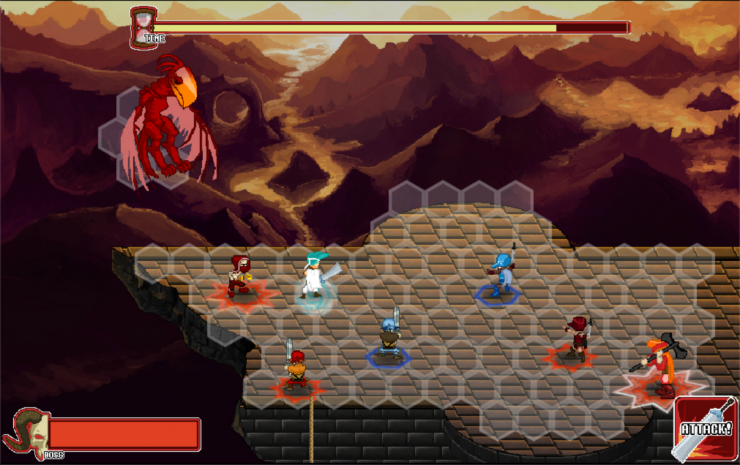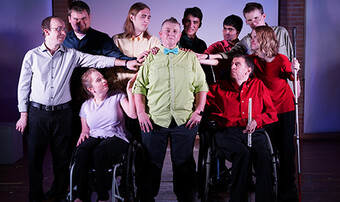Video Games as an Art Form Part 2
Game Design for Theatre Professionals
What can theatre artists learn from gamers? How do you effectively incorporate technology in a video game turned theatre performance? This series addresses audience engagement in theatre and gaming, and the need for relevance in theatre to the gaming generation by looking at the process behind an innovative show in San Antonio, Texas.
I am going to teach you how to make a video game. Sort of. You can’t do that in one article. But I am in a good place to help. As a playwright and producer who also makes video games, I want to talk you through the process of how we made our game. Heroes Must Die is my mad project that just wrapped up, which combines a story-driven video game with its sequel as a live-action theatre show set in the world of games. In the first article in the series, I talked about the background, vision, and planning for the project. Now I’d like to give a peak into the process of what it actually takes to create a video game by talking through the process of creating the Heroes Must Die game, with the theatre perspective in mind.

The Team
Possibly the hardest part of the whole project was establishing a long-term team. We are an indie developer, and what little the team was paid came out of small grants or my own pockets. So this took devoted people with an artistic vision and a passion to see a cool project through.
Many of you have put together similarly insane projects, but I do want to put it into perspective. Start by imagining putting on a show outside any theatre—so you need to find a venue, rehearsal space, all your technical professionals and equipment in addition to the director, actors, and so on. Then imagine it is going to take three years instead of three months. Then imagine you still need to time it with a regular theatre season. That’s what we were working with. But even with some turnover and stops and starts, I found a wonderful team of talent and drive.
Some roles in games have analogues in theatre, others don’t. I’ll try to break it down.
- Writer: If your game has a story, you need someone to write it—the scenes, the dialogue—like any other art form. But I said “if.” Many games don’t have stories. While you could surely invent a story for Pac-Man, the fact is that this game is just about its perfectly-tuned mechanics, and no writer was credited. I served as the writer for Heroes Must Die, and a story was needed because I planned for the theatre sequel, so we wanted a story that continued across media.
- Designer: Kind of like a director, the designers of a game can both be responsible for the overall vision of how it plays (perhaps more like a dramaturg), and the nitty-gritty of laying out levels, scripting events, which are somewhat like blocking a scene. The big difference is mechanics. You attend a show—and maybe you interact with it—but you play a game. And someone needs to come up with, implement, and test those mechanics of actual gameplay. My programmer and I co-designed this game with me serving as creative lead, but he gave lots of input in the mechanics as he programmed them.
- Artists: Different games have different artistic needs, but even something as simple as an arcade shooter needs art assets. Our 2D-RPG meant we needed a bazillion frames of animation, backgrounds and objects, animated effects, and so on. Four artists contributed regularly to this game with help from a fifth. Most people can conceive what a game artist does. But in addition to thinking of them as set painters or lighting designers, think of them almost like actors—creating the assets (which include the characters!) that populate the world.
- Composer: Composers for games are extremely important. A composer is perhaps not as critical to a game as one would be for a musical, but their touch is felt throughout. Heroes Must Die, like most games, has literally every moment covered by music, so the composer helps contribute to the feel of the game as a whole and individual moments.
- Programmer: All technical professionals rolled into one and then some, the programmer really creates the game by writing the code, developing the tools, and making the building blocks that allow art, music, story, and mechanics to work together to become an actual game. The programmer is also a member of a perpetual hell week because they endlessly fix the bugs that pour in as the game is tested over months.

The lessons learned from audience interaction and engagements, integration of technology and other media, and of course the heart of games—having fun—can lead to inspired new works.
The Process
Games follow the general pre-production > production > post-production plan of most large endeavors. In pre-production you come up with the concept (which could include a basic outline of story, mechanics, or both), figure out the tools, platform, and technology to be used, get some concept art, or other mockups to give the flavor. Concept art (and music) proved especially important to this project, because 1) with 2D animation a lot of animation frames were needed so it was important to nail down the characters early, and 2) the visuals and audio would carry through to the show so we wanted them to have the right feel.
Production proceeds as expected—the actual programing, creating art, writing, composing, and designing of the game. This is a much more iterative process than theatre. There are some similarities. The idea of “rapid prototyping” is somewhat similar to a workshop, or staged reading. For example, the goal is getting a minimally-working version of some aspect of the game to see how it feels, and if it plays like expected before putting in detailed work.
However, the testing and changing happens daily. A problem in one area, or an inspired idea in another can change the whole in good ways, which is much more true in video games. However, it can also lead to more problems. For instance, the art assets won’t work in the current system so the art changes to work with the programming, which changes the feel of the story. Now with the story and art changed, the mechanics need to change as well, and each of those changes break the programming. Just when you finally get some version working, you realize it doesn’t play how you thought and everything needs to change again, with all the stops and starts and bugs that come with. Now do this over and over for years.
So making games is not for the faint of heart, though no art is. Because of the particular set of skills needed combined with the scope and technology, I wouldn’t necessarily recommend that all other artists try a hand at creating games. But playing games? Absolutely. The lessons learned from audience interaction and engagements, integration of technology and other media, and of course the heart of games—having fun—can lead to inspired new works. And that is just how Heroes Must Die was inspired. Next time I will talk about the details of putting together the massive show. In the meantime, play some games!










Comments
The article is just the start of the conversation—we want to know what you think about this subject, too! HowlRound is a space for knowledge-sharing, and we welcome spirited, thoughtful, and on-topic dialogue. Find our full comments policy here